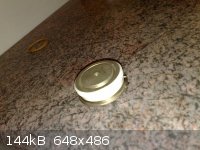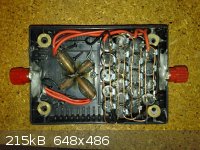
holmes1880 - 19-1-2011 at 17:07
Ok, so instead of making power supply, I'm just going to buy it. Capacitor, I'm still undecided on because I'm not sure if the power supply can load
it up and whether I even need to have 2kV and 1uF vs. 500V and 5000uF. Either one should vaporize thin 40AWG nichrome wire. Oh, and I won't be using
coaxial cables, just thick copper cables.
P.S. Here's the source that suggests 500V is sufficient for initiation http://www.corelab.com/pe/owen/CMS/OwenOilTools/pdf/04_sfs-0... I could have misinterpreted it, though.
Please, voice your suggestions or recommendations.
[Edited on 20-1-2011 by holmes1880]
Bert - 19-1-2011 at 20:56
The corelab.com link appears to be broken-
holmes1880 - 19-1-2011 at 21:06
Yeah, fixed it. There was another source that tells it needs 800V, but I saw references mentioning 500V as the explosive threshhold @ 1uF.
Rain - 20-1-2011 at 10:43
This is a picture of my EBW setup.
It is camera caps at +- 80mf times what you see.
This is more than enough energy (in Joules) to initiate PETN when in direct contact with the bridge wire (0.15mm diameter by +- 2mm length).
Ive had successful results from as little as five capacitors in parallel.
The switching is done via a thyratron setup using bullet points.
The two ionizing points are connected to a stun-gun module.
As soon as its fired the air is ionized and the switch is closed.
It does corrode the bullet points after a while, but tungsten carbide points could be used if available (like to me for instance  ).
).
The other image shows a solid state thyristor which is used in high current DC switching in substations (Im an electrician  ).
).
This thyristor has a high tolerance to fast, very high current and quite high voltage (flash over limit determined by distance, thus size).
It is much better than the thyratron, as no energy is lost in an arc flash as is created when the thyratron switches.
Or you could just build your own capacitors for spark initiation.
There is no need for such high voltages to do EBW's.
The amount of energy injected into the bridge wire just needs to be calculated by E=[C.V^2]/2
E=Energy in joules
C=Capacitance in Farads (remember microfarads= *10^-6)
V=Voltage across the capacitor bank.
An example:
E= [[(80*10^-6)(10caps)]*250V^2]]/2
= 25Joules
(Thats enough to kill you BTW)
Now go and see how little Joules is needed to initiate PETN.
This is the best explosive EVER!
Keep in mind the density and crystal shape of the powder.
Remember it is initiated in a "detonation train" configuration.


gregxy - 20-1-2011 at 11:20
The voltage you need also depends on the length of your wires. If you have hundreds of feet of wire (as in large
blasting operations) you will need a large voltage to drive the
current through all the wire.
I also think the electrical power requirements can be lowered
by using a resistive explosive instead of the ebw. The reason
is that the ebw has a very low impedance from the start,
so most of the energy goes into heating the long cable
and burning up your spark-gap.
The resistive exp will initially have a high impedance, so most
of the elect. energy will go into heating the explosive.
Once that the expl. is "hot" and the reaction is starting,
its impedance will drop sharply and there will be a large
inrush of current & elect. energy triggering the detonation.
quicksilver - 20-1-2011 at 12:45
gregxy makes a point that has a great deal of merit in that length of wire infers resistance. Additionally it's actually the current that makes the
pop when all is said and done the conception of Ohm's Law is looking at voltage and current as one would look at flowing water.
The voltage is the volume of water and current the speed - in that a garden hose can have the same amount of water from the tap but a nosel can
increase that same water level to a higher pressure element. It's not the best analogy (You understand what I'm trying to say here) but current will
be a serious issue in any EBW setup.
Quality EWB products seriously cost $1500-3000, so the level of design is quite magnificent for a continual, reliable product. The caps alone can cost
a pretty penny and design features built into the professional one are phenomenal. But designing a unit that will function should be no serous
problem. In the long terms however you need components that are able to withstand a great deal of "charge & discharge".
[Edited on 20-1-2011 by quicksilver]
holmes1880 - 20-1-2011 at 15:12
Valid points, everyone. Silver, you don't actually think the overall joule amount rushing into the little wire matters and it's only the voltage that
causes the vaporization.
@ Rain, how long were the cables you used and what gauge were they?
crazedguy - 20-1-2011 at 22:21
I'm no electrician but every thing I have seen its the amperage that would cause it to explode 500V is rather low as far as volts go but 200 or more
amps that is a lot of power at 500V.
quicksilver - 21-1-2011 at 09:03
@ holmes1880
NO SIR: it's the current! Lets say we look at a standard LA car battery. That guy is pumping out quite a few amps. Lay a very thin wire across the
poles and you'll see it pop at only 12Vdc but if we were to connect a driver for a LOTP transformer (a "flyback) from a TV (at perhaps 20Kv but only
10-30ma) and do the same, the wire would not pop to the same level of intensity as it would with the car battery @ 12V. Lead Acid car batteries are
VERY effective amperage storehouses and should be considered as motorcycle batteries and other smaller ones could be obtained for a fairly low cost.
capacitors can be excellent means of boosting current in their discharge and in they systemic role. A C/D box does this. Do a web search for IDEAL
Blasting products. This is a very professional company and should not be contacted if you are not in the industry but it does have various blasting
boxes and you can get an idea via both Joules and amperage what the level should be. The actual EBW machines are often mfg with a inverter connected
to a truck or automobile battery and then to a cap bank and a pulse transformers. These are of the highest level of quality and they are NOT cheap.
But you could get basic idea of what's being sent down line. Often in serous projects, concept blasting with Nonel and direct EBW are "chained" with
a cryptographic transmitter to save on wire as 100yrds of wire would be a serious resistor unless it was rather thick and costs would skyrocket.
Even the old fashioned generator type blast boxes will generate a great deal of current. And it's very easy to make a generator today by simply using
certain motors BACKWARD!
Did you know that if you were to make a "crank" of sorts for turning and to put that into the chuck of a BATTERY OPERATED DRILL - THEN TURN IT
RAPIDLY.....IT WOULD PRODUCE THE -=SAME=- CURRENT 7 VOLTAGE THAT THE ORIGINAL BATTERY FED INTO IT??? YES! You can make a simple hand turned blast box
(or generator) by using a battery operated drill motor back ward!
THE GEAR RATIO WOULD SUFFICE TO MAKE IT EASIER THAT TO DEMAND THE SAME rpm AS IT COULD BE ADJUSTED AS A SLOW TURN FOR FULL ROTATION AND THERE YOU
HAVE A GENERATOR .....
Pretty neat way to develop a non-battery unit as well.
When looking at professional products it's best just to look and not contact; in these days of psychos and idiots. There are a great deal of resources
that a well tuned eye can make use of quiet observation. Also....check the ISEE web site; in their "Library" section there MAY be a book or two on the
concept of EBW and it's progression from the 1970's till today!
[Edited on 21-1-2011 by quicksilver]
Zeus - 21-1-2011 at 16:55
I've been thinking about using an EBW system and I have a reasonable knowledge of electronics (full amateur radio license), I don't have the
precursors to the "nice" primaries and organic peroxides scare me.
I'd like to know if an EBW system can be too powerful? I intend to work with picric acid and perhaps ETN if I can get erythritol.
crazedguy - 21-1-2011 at 17:31
Quicksilver how many of those single circut machines are EBW machines because I am looking at them right now none say that they are EBW and the max
joules input I have seen is 7.2?
Read more into them and I don't think any are even close to EBW power required, but I may be wrong.
Also what would it cost to make a home made EBW setup? Link to a good site for caps would be greatly appreciated.
[Edited on 22-1-2011 by crazedguy]

 ).
). ).
).